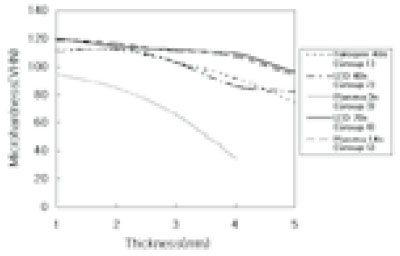Articles
- Page Path
- HOME > Restor Dent Endod > Volume 28(2); 2003 > Article
- Original Article Polymerization ability of several light curing sources on composite resin
- Hye-Jin Shin, Jin-Woo Kim, Kyung-Mo Cho
-
2003;28(2):-161.
DOI: https://doi.org/10.5395/JKACD.2003.28.2.156
Published online: March 31, 2003
Department of Conservative Dentistry, College of Dentistry Graduate School, Kangnung National University, Korea.
- Corresponding author (drbozon@kangnung.ac.kr)
Copyright © 2003 Korean Academy of Conservative Dentistry
- 872 Views
- 0 Download
- 1 Crossref
Abstract
-
The purpose of this study is to evaluate the polymerization ability of three different light sources by microhardness test. Stainless steel molds of 1, 2, 3, 4 and 5 mm in thickness of 7 mm in diameter were prepared. The hybrid composite Z100 was packed into the hole of the mold and curing light was activated for designated time. Three different light sources, conventional halogen, light emitting diode, and plasma arc, were used for curing of composite. Two different curing times applied; one is to follow the manufacturer's recommendation and the other is to extend the curing time of LED and plasma arc for balancing the light energy with halogen. Immediately after curing, the Vickers hardness was measured at the bottom of specimen.The results were as follows.In conclusion, this study suggested that plasma arc needs properly extended curing time.
- 1. Althoff O, Hartung M. Advances in light curing. Am J Dent. 2000;13(Special No):77D-81D.PubMed
- 2. Stahl F, Ashworth SH, Jandt KD, Mills RW. Light-emitting diode (LED) polymerization of dental composites: flexural properties and polymerization potential. Biomaterials. 2000;21: 1379-1385.PubMed
- 3. Mills RW, Jandt KD, Ashworth SH. Dental composite depth of cure with halogen and blue light emitting diode technology. Br Dent J. 1999;186(8):388-391.PubMed
- 4. Rueggeberg FA, Twiggs SW, Caughman WF, Khajotia S. Lifetime intensity profiles of 11 light curing units. J Dent Res. 1996;75: 380.
- 5. Nakamura S, Mukai T, Senoh M. Candela-class high brightness InGaN/AlGaN double heterostructure blue-light-emmiting diodes. Appl Phys Lett. 1994;64: 1687-1689.
- 6. Haitz RH, Craford MG, Wiessman RH. Devices, measureaments and properties. Handbook of optics. 1995;Vol 2: NewYork: McGraw-Hill; 1-39.
- 7. Fujibayashi K, Ishimaru K, Kohno A. A study on light activation units using blue light-emitting diode. J Jap Dent Pres Acad. 1996;39: 180-188.
- 8. Fujibayashi K, Ishimaru K, Takahashi N, Kohno A. Newly developed curing unit using blue light-emitting diode. Dent Jap. 1998;34: 49-53.
- 9. Peutzfeldt A, Sahafi A, Asmunssen E. Characterization of resin composites polymerized with plasma arc curing units . Dent Mater. 2000;16: 330-336.ArticlePubMed
- 10. Hofmann N, Hugo B, Schubert K, Klaiber B. Comparison between a plasma arc light source and conventional halogen curing units regarding flexural strength, modulus, and hardness of photoactivated resin composites. Clin Oral Investig. 2000;4: 140-147.ArticlePubMedPDF
- 11. Munksgaard EC, Peutzfeldt A, Asmussen E. Elution of TEGDMA and BisGMA from a resin and a resin composite cured with halogen or plasma light. Eur J Oral Sci. 2000;108: 341-345.PubMed
- 12. Nomoto R. Effect of light wavelength on polymerization of light-cured resins. Dent Mater J. 1997;16(1):60-73.ArticlePubMed
- 13. Jandt KD, Mills RW, Blackwell GB, Ashworth SH. Depth of cure and compressive strength of dental composites cured with blue light emitting diodes (LEDs). Dent Mater. 2000;16: 41-47.ArticlePubMed
- 14. Mills RW, Uhl A, Blackwell GB, Jandt KD. High power light emitting diode (LED) arrays versus halogen light polymerization of oral biomaterials: Barcol Hardness, compressive strength and radiometric properties. Biomaterials. 2002;23: 2955-2963.ArticlePubMed
- 15. St-Georges AJ, Swift EJ, Thompson JY, Heymann . Curing light intensity effects on wear resistance of two resin composite. Oper Dent. 2002;27: 410-417.PubMed
- 16. Sharkey S, Ray N, Burke F, Ziada H. Surface hardness of light-activated resin composites cured by two different visible-light sources: An in vitro study. Quintessence Int. 2001;32: 401-405.PubMed
- 17. Gagliani M, Fadini L, Ritzmann RM. Depth of cure efficacy of high-power curing devices vs traditional halogen lamps. J Adhes Dent. 2002;4: 41-47.PubMed
- 18. Knezević A, Tarle Z, Meniga A, Sutalo J, Pichler G, Ristic M. Photopolymerization of composite resins with plasma light. J Oral Rehabil. 2002;29: 782-786.PubMed
- 19. Kelsey WP, Blankenau RJ, Powell GL, Barkmeier WW, Stromberg EF. Power and time requirements for use of the argon laser to polymerize composite resin. J Clin Laser Med Surg. 1992;10: 273-278.PubMed
- 20. Koliniotou-Kubia E, Jacobson PH. The effect of irradiation time on the physical properties of light-cured resins. Clin Mater. 1990;6: 21-28.ArticlePubMed
REFERENCES
Tables & Figures
REFERENCES
Citations
Citations to this article as recorded by 

- Power density of light curing units through resin inlays fabricated with direct and indirect composites
Hoon-Sang Chang, Young-Jun Lim, Jeong-Mi Kim, Sung-Ok Hong
Journal of Korean Academy of Conservative Dentistry.2010; 35(5): 353. CrossRef
Polymerization ability of several light curing sources on composite resin


Fig. 1
Schematic drawing of constructed device used to prepare resin sample
Fig. 2
Microhardness of each light source at each thickness
Fig. 1
Fig. 2
Polymerization ability of several light curing sources on composite resin
Experimental groups designated with different light curing units and curing times
*: Watts × seconds/cm2 = Joules/cm2
Means and standard deviation (SD) of microhardness
Significance testing of mean microhardness of each light source within each depth
*: not statistically significant (p > 0.05)
Table 1
Experimental groups designated with different light curing units and curing times
*: Watts × seconds/cm2 = Joules/cm2
Table 2
Means and standard deviation (SD) of microhardness
Table 3
Significance testing of mean microhardness of each light source within each depth
*: not statistically significant (

 KACD
KACD





 ePub Link
ePub Link Cite
Cite

